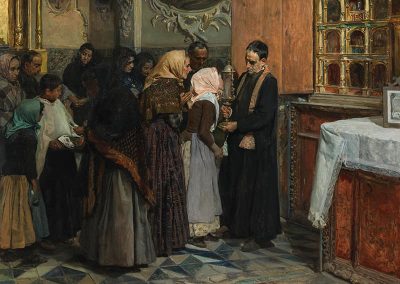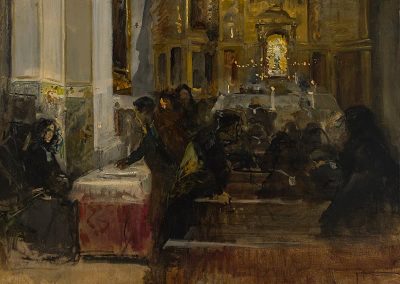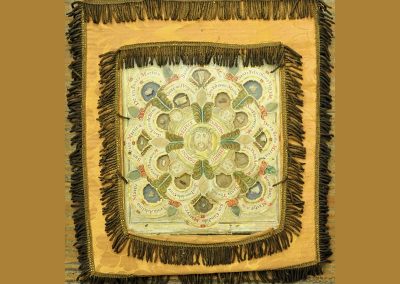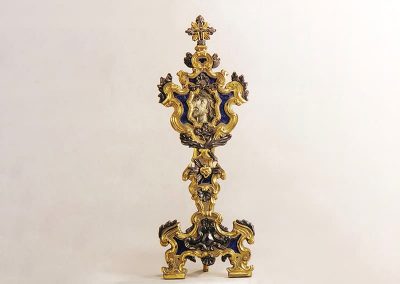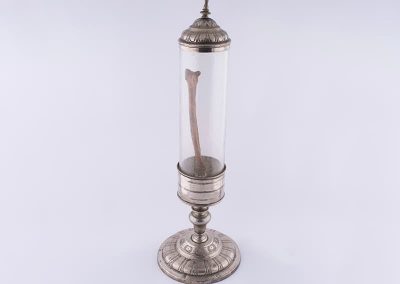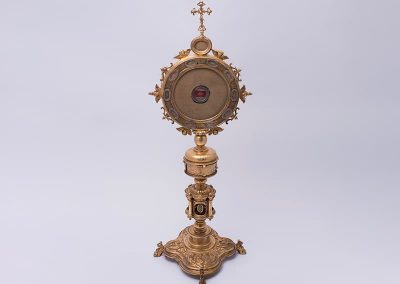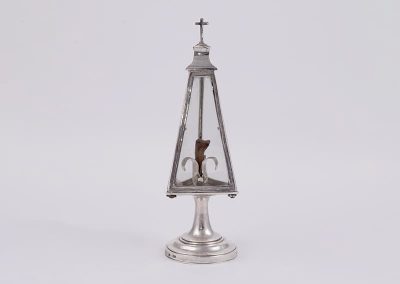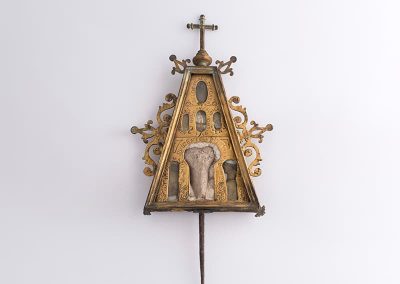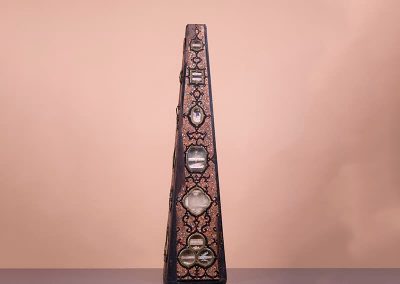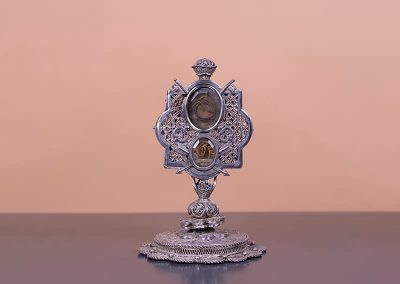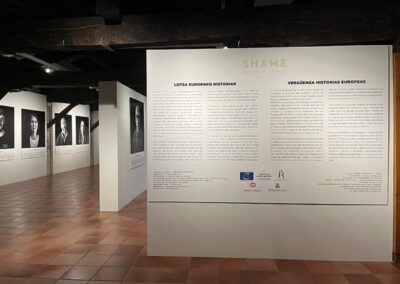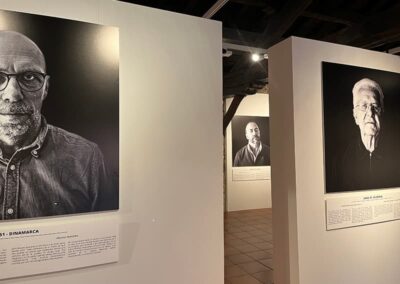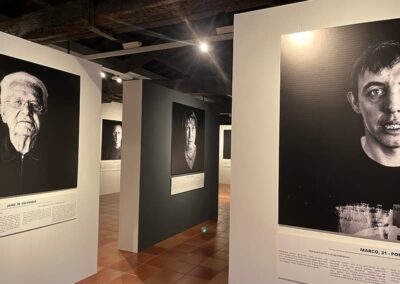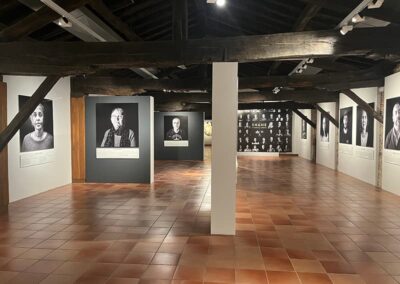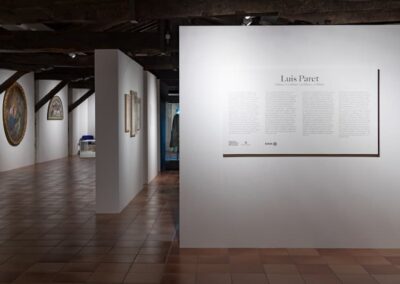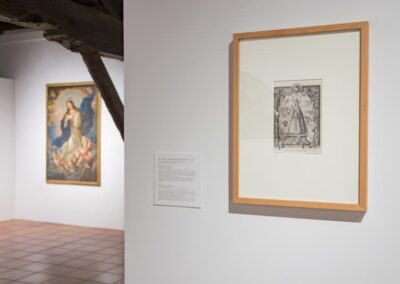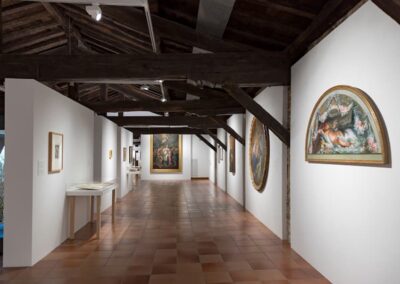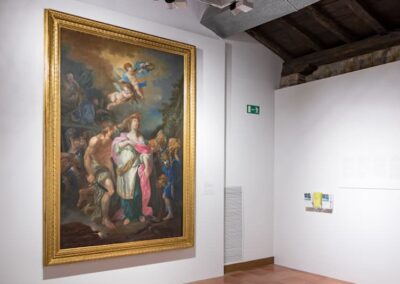Our exhibitions
Current exhibition
There is currently no temporary exhibition open to the public.
Previous exhibitions
Sorolla y las reliquias
Una oportunidad única para contemplar dos magníficas obras del pintor Joaquín Sorolla
Del 16 de noviembre de 2023 al 31 de enero de 2024
Prorrogada hasta el 29 de febrero

Una oportunidad única para contemplar dos magníficas obras del pintor Joaquín Sorolla y, en paralelo, adentrarnos a través de más de medio centenar de objetos en un mundo que combina la religiosidad con el arte: el de las reliquias y los relicarios.
El Museo de Arte Sacro, con la colaboración directa del Museo de Bellas Artes de Bilbao, se une con esta exposición a los actos conmemorativos del centenario de la muerte de Joaquín Sorolla (Valencia, 1863-Cercedilla, Madrid, 1923).
La pintura religiosa de Sorolla
A Sorolla le identificamos especialmente con los paisajes costeros en los que despliega un notable tratamiento de la luz y el color. Pero también destacó, sobre todo al comienzo de su carrera, por sus escenas costumbristas de temática religiosa. Entre ellas sobresalen los interiores de iglesias, de los que son magníficos ejemplos El beso de la reliquia y Mesa petitoria, cedidos por el Museo de Bellas Artes de Bilbao para esta exposición.
En El beso de la reliquia el artista muestra su gran capacidad para articular una abigarrada composición en la que destaca un hábil dibujo y el uso maestro de la luz y el color. En una capilla lateral de la iglesia de San Pablo de Valencia, el párroco presenta una reliquia para ser besada por una heterogénea feligresía.
Por su parte, en la Mesa petitoria se combina espléndidamente una paleta de colores tierra y grises con los toques de luz generados por las velas. Obra de carácter esbozado, el cuadro recoge el instante en el que unas mujeres sentadas a una mesa piden y recolectan donaciones y ofrecen artículos devocionales durante el culto.
Pero la exposición va más allá de estas dos brillantes obras de Sorolla. El beso de la reliquia nos acerca al mundo de las reliquias. Devoción popular, creencias, mentalidades…
Las reliquias…
El culto a las reliquias se inició ya en los primeros momentos del cristianismo, cuando eran venerados los restos de las y los mártires.
Durante la Edad Media se extendió por todo el mundo cristiano. En un tiempo en el que eran corrientes la inseguridad, la enfermedad, el hambre… la gente buscaba protección y ayuda en los poderes celestiales. Y las reliquias, los restos de santas y santos, se convirtieron en sus intermediarios.
La reliquia era un resto tangible, material, de la santidad. Podía interceder ante lo sobrenatural. Podía recibir de forma directa los ruegos y súplicas del devoto y atenderlas de forma inmediata, solucionando problemas concretos que planteaba la vida cotidiana: una enfermedad, dificultades económicas, asuntos familiares…
Signo de prestigio y de ortodoxia, el mundo del barroco conoció un resurgir de este culto de las reliquias, que se mantendría vivo prácticamente hasta nuestros días.
Hoy, en una sociedad cada vez más laica, el culto por las reliquias parece haber desaparecido. O tal vez ha cambiado de protagonistas.
… y los relicarios.
Las reliquias debían estar protegidas en un estuche adecuado, digno de su contenido: el relicario. Y la exposición Sorolla y las reliquias dedica buena parte de su espacio a mostrar la variedad de estos contenedores.
Sirvan como ejemplo la lipsanoteca de la ermita de San Lorenzo de Ozerinmendi (Zeanuri), que puede remontarse al siglo XII o la mano de plata del Gorputz Santue (Cuerpo Santo) de Errigoiti, una momia natural que ya desde el siglo XVI curaba problemas del habla, como la tartamudez.
Las tipologías son muchas: con forma de cilindro (como la del cuadro de Sorolla) es la de Abadiño, y las hay de tipo custodia (Sukarrieta, Markina), cruz (Berriz), obelisco (Bermeo), pirámide (Lekeitio), templo clásico (Berriz)… Y los materiales: sobre todo los hay de plata, pero también de madera, latón, tejido…
Además, están los relicarios colgantes o las estampitas-relicario, como la que nos muestra una crucecita realizada con madera de un avellano plantado por Santa Teresa.
Unas veces contienen una única reliquia, pero otras son cientos de ellas: ¡362 acumula el relicario arquitectónico del convento de la Vera Cruz en Berriz! (ordenadas además por meses).
Entre las más valoradas están las relacionadas con Jesucristo, especialmente los Lignum crucis, presuntos fragmentos de la cruz en la que fue crucificado. Tres de ellos pueden verse en la exposición, piezas barrocas de los siglos XVII y XVIII procedentes de la catedral de Santiago y de la iglesia de los Santos Juanes (Cofradía de la Vera Cruz) de Bilbao y de la iglesia de San Juan Degollado de Molinar, en Gordexola.
Un capítulo especial merecen las reliquias de contacto: objetos que han tocado a las y los santos. En la exposición pueden verse algunas estampas con hojas y flores “tocadas al Santo Sepulcro”. Pero la pieza más destacada es la máscara mortuoria de la beata Rafaela de Ybarra, conservada por la Congregación de los Ángeles Custodios en Bilbao.
El ritual
Otro aspecto que se refleja en la exposición, tomando como referente El beso de la reliquia de Sorolla, es el de la vestimenta y el “aparataje” de este acto y de otros similares, como se aprecia también en la Mesa petitoria.
Shame. European stories
Victims of child abuse share their stories
From 16 February to 15 March 2023

An exhibition that sought to shed light on an issue that affects us all: child abuse.
The rights and dignity of thousands of children across Europe have been violated. Violations that have occurred in various contexts and in various ways.
The exhibition was intended to give visibility to these children, now adults. Their portraits, large black and white photographs, and their own words denouncing the shame: the unjustified shame that intoxicates those who have suffered violence; the shame that those who have abused should feel; and the shame of a Europe that fails to manage this dramatic situation.
To raise awareness; to promote legislative changes; to break the silence, the stigmatisation, the impunity, the cover-up and even the complicity. These were the objectives of the exhibition.
Exhibition organized by the Guido Fluri Foundation (Switzerland) and Justice Initiative, with photographs by Simone Padovani.
Luis Paret in Bilbao
From 9 July to 17 October 2021

The painter Luis Paret y Alcázar (Madrid, 1746-1799), a strict contemporary of Goya, was one of the best representatives of the Rococo aesthetic imported from France. His eventful life led him to settle in Bilbao between 1779 and at least 1787. During this time Paret was intensely active in the town, where he left an impressive artistic mark. He painted, but also designed furniture, altarpieces and fountains, decorated public and private rooms… This was probably the richest and most varied period of his production.
The double exhibition – split between the Museum of Sacred Art and the Bilbao Fine Arts Museum – brought together a wide range of works by Paret produced during his stay in Bilbao. It also included works by other court artists who worked for/in Bizkaia in those years and by local artists who followed in their footsteps. The aim was not only to show the work of Paret, but also the aesthetic change that the Territory was undergoing at that time, from Rococo to Neoclassicism, a leap in which the painter from Madrid had a great deal to say.
The exhibition was complemented with other activities: guided tours of the places where Paret lived and worked, some by land and others by river; installation of panels with works by Paret in the places in Bilbao where Paret had painted them (in order to contrast the paintings with the current reality); restoration of one of the fountains designed by Paret (the one located in the Plaza de los Santos Juanes); and an Art Conference in the form of a congress on the subject studied.

